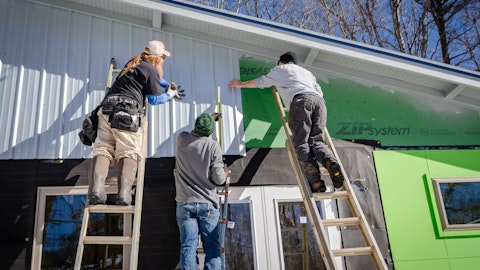And yet I think when you look at any given year, it never really plays out that way because the macroeconomic factor is probably way heavier than the seasonality at times. But given that, Mark, I’ll check my recollection, I mean, at most 10%.
Mark Fusler : Yeah, I was going to say around 5%, probably.
Bill Boor : 5% to 10%. But again, we are hitting the better part of that from a seasonality perspective.
Danny Eggerichs : Okay. Got it. And then maybe just touching on ASPs again. You kind of commented that within the backlog, you’re seeing some lower ASPs. So I guess — is that a good proxy for this current quarter on ASPs? And within that, is that just kind of mix then? Or what are we seeing there?
Bill Boor : Yeah. What I would say is we’ve kind of had a movement we’ve talked about in previous quarters that if you looked on a year-over-year basis, we’re selling more single section units and multi-section units. So I would suggest, and I look around to see your reactions to, I would suggest that our lower value in the backlog is more driven by that change than it is by the fundamental pricing of a given unit. I think that’s your question. Let me know — does that answer your question?
Danny Eggerichs : Yeah. Yeah. You just kind of mentioned that pricing was holding steady, but backlogs, ASPs were kind of coming down. So I was just wondering if that was mix or what — so thank you, you answered that.
Bill Boor : Yeah, the backlog moves more to a character, it’s got more single lights than multi-section, then you’re going to naturally see that value per unit go down, right?
Danny Eggerichs : Yeah. Okay. That makes sense. Maybe just one last more on maybe the Anthem product just kind of initial interest. I know you’re showing that off of the Louisville show and how big you think that could be and what the market could potentially be like for that certain product?
Bill Boor : Yeah, we’re obviously really excited about it. I mean, this is a change that’s been made after a lot of work at the industry level basically with HUD to allow multifamily units to be coded under the HUD code. And we are excited about it. We had a launch event, one of our — basically our lead plan on this is the Rocky Mount Virginia plant. And we had a launch event in early December, and I was there, and I was really impressed by the support we’re getting not only from dealers and community operators, but also from municipalities showing up looking for solutions to their density and affordability issues. And so we’ve talked about it as being a nationally available. We’re going to produce that variations of the [indiscernible] product.
I mean, there’s more than one per plant, the variations that we’re going to produce in plants across the country. So yeah, I don’t have any numbers for you to share at this point, but we’ve been really excited about the interest level. And if you think about it, if you’re running — let’s just take the example of a community operator. The opportunity to get some density, you’re going to get more revenue essentially from a given lot. And at the same time, those two residences or households are going to both benefit from the density with lower cost. And so that’s what saw in the affordability issue is all about. So I appreciate you asking because obviously, we’re pretty excited about it.
Danny Eggerichs : Yeah, sounds like something lot of good stuff. So I’ll leave it there, thanks.
Bill Boor : Thank you.
Operator: And one moment for our next question. And our next question will be coming from Jay McCanless of Wedbush. Your line is open, Jay.
Jay McCanless : Hey, good morning, everyone. So Bill, could you maybe talk about the Kentucky Dream acquisition, how many owned stores does that take Cavco to now? And what’s kind of your outlook for more acquisitions like this in the coming year?
Bill Boor : Yeah. We’ve had a bit of an increase in our total owned stores. And it came — a big chunk of that came through the Solitaire acquisition a year ago. We were in the low 40s before that. Solitaire, I think, brought us 22%. And then with a few greenfields and then the Kentucky Dream Homes acquisition, we’re at 72% now. So I think you’re asking for a little more detail on those assets. Is that right, Jay?
Jay McCanless : Yeah. And just are there other larger dealer chains out there that you might be looking at from an M&A perspective and if there are, what kind of — is the goal to get to 100, 150 what’s kind of your long-term vision for the retail stores?
Bill Boor : Yeah. Taking back and tell you how we think about retail real quickly. We have not generally had a strategy of trying to grow retail for its own sake. We’ve had a strategy that’s been very clear that — we want to look at every one of our plants in a local market and make sure we’ve got the right access to market. So if we look down the road and we see, for example, a lot of integration by competitors and that increases our risk of distribution. That’s when we try to figure out a good solution. That solution could be anything from developing a closer partnership with an existing dealer, independent dealer to greenfield and then two acquisitions and the example of Kentucky Dream Homes. So we don’t have a goal to reach a certain level.
We’re not pushing growth in the retail segment necessarily, we’re only happy to make a good acquisition when it’s both a good investment and improves our distribution. Kentucky Dream Home is a great example of that. I mean, Duston has run a great business. They’ve built a great business, really thrilled at the fact that he’s staying on board and his management team stay on board because they’re here at what they do. They have five stores in Kentucky and in Florida. And yeah, we sold them or repurchased them during the third quarter.
Jay McCanless : Got you. The other thing I wanted to ask about is what you’re talking about before, Allison with the increased cost of goods sold? Is it still just OSB? Or are you starting to see some wage inflation kick in maybe what are the drivers that are driving the COGS line up?
Allison Aden : Yeah. So on the COGS, Jay, it’s largely the commodities. As we mentioned last quarter, with the focus, of course, on OSB and lumber and we stay pretty close to it. And currently, it looks like it’s a similar trend to what we talked about last quarter.
Jay McCanless : That’s all I have. Thank you.
Bill Boor : All right. Thanks, Jay.



